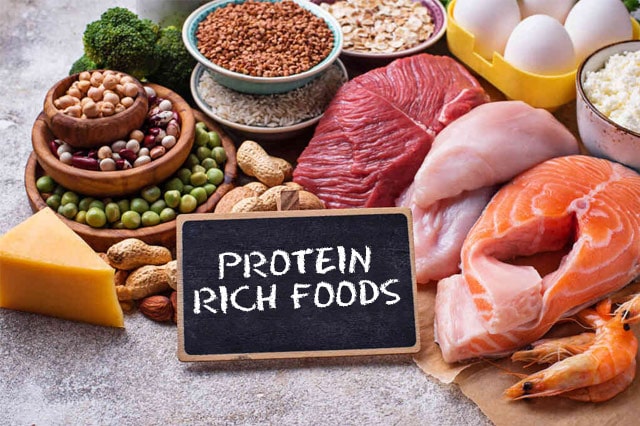Table of Contents
High protein Foods: Protein plays a crucial role in the human body as it is a fundamental building block for cells. It is responsible for repairing and creating new cells, which are essential for various bodily functions. Enzymes, for instance, are a type of protein that aids in the breakdown of food, enabling efficient digestion and nutrient absorption

Hormones, too, are proteins that regulate various processes in the body, ensuring proper functioning. Moreover, the immune system heavily relies on proteins, specifically antibodies, to defend against infections and diseases.
High Protein Foods
It is generally believed that only non-vegetarian food contains protein. But vegetarians don’t need to worry about it, because milk, pulses, soya are rich in proteins. Along with this, green vegetables also contain protein. Telling about some such High Protein Foods.
Low-Fat Dairy Products
Low-fat dairy products are dairy items that have had some or most of the fat content removed during processing. A Protein-Packed Option Greek yogurt is a rich source of protein, boasting 20 grams per seven-ounce container. It also provides essential nutrients like calcium (230 milligrams, 18% DV) and vitamin B12 (1.04 micrograms, 43% DV). Incorporating low-fat dairy, such as Greek yogurt, into your diet can be beneficial, and studies suggest that consuming yogurt can reduce the risk of type 2 diabetes.
Understanding Daily Value (DV) The Daily Value (DV) on food labels represents the amount of a nutrient in one serving relative to the recommended daily intake. The U.S. Food and Drug Administration (FDA) sets these values to help consumers make informed choices about their nutrition.
Lentils
The Plant-Based Powerhouse Rich in Protein and Fiber Lentils are a top plant-based protein source, offering 18 grams of protein and 15 grams of fiber per one-cup serving (53% DV). They also contain 731 milligrams of potassium (15% DV) and have the highest total phenolic content among common legumes, providing protection against heart disease, cancer, and diabetes.
Versatile and Nutritious Lentils can be incorporated into a wide array of dishes, from curries and stews to salads and meatless meatballs, making them a delicious and nutritious addition to your meals. Lentils are a valuable addition to a balanced and nutritious diet.
Beans and Chickpeas
Protein-Rich Legumes Protein and Fiber Content Beans and chickpeas are excellent sources of protein, offering 17 grams and 11 grams per cup, respectively. They are also high in fiber (40% DV for beans) and contribute to reduced inflammation and protection against obesity, diabetes, heart disease, and cancer due to their polyphenol antioxidants.
A Versatile Addition to Your Diet Incorporate beans and chickpeas into various dishes, such as breakfast scrambles, chilis, soups, salads, curries, and even desserts like chickpea cookie dough and black bean brownies.
Both beans and chickpeas are valuable additions to a balanced diet. They offer a combination of protein, fiber, and essential nutrients that can contribute to overall health.
Tofu
A Plant-Based Protein Staple Nutritious and Adaptable Tofu, a versatile plant-based protein, offers approximately 8.67 grams of protein and is a good source of calcium (209 milligrams, 16% DV) and iron (1.36 milligrams, 7.5% DV) in a three-ounce portion. Studies suggest that soy protein in tofu may offer health benefits, especially for menopausal women, including improved cholesterol levels and reduced blood pressure.
Incorporating Tofu into Your Meals Tofu can be used in a wide variety of dishes, from salads and stir-fries to main dishes and desserts, generally, tofu is considered a relatively high-protein food among plant-based options.
Chicken: A Lean Meat Option
Protein and Essential Nutrients Chicken is a lean and versatile protein source, providing 8.56 grams of protein per ounce. It also contains vitamin B12 and zinc, essential for energy production and immune function. Studies suggest that choosing white meat like chicken over red meat can help reduce inflammation and lower the risk of metabolic diseases like diabetes.
A Staple in Many Diets Chicken is widely consumed and can be incorporated into a multitude of dishes, from sandwiches and salads to stir-fries and casseroles, making it an easy choice for meeting protein needs.
FAQs – High Protein Foods
What is the best source of protein?
For the supply of protein in the body, definitely include meat and fish, eggs, milk and milk products, seeds and nuts in your diet.
How to get 100 grams of protein a day?
Eggs, chicken, fish and dried fish can provide you with a good amount of protein. If you are a vegetarian, then definitely eat protein-rich foods like soybeans, lentils, kidney beans, and green vegetables.
How much protein does the body need in 1 day?
Men need 50 grams of protein per day. At the same time, every woman needs 46 grams of protein per day.
Conclusion
A Balanced and Nutritious Diet By incorporating a variety of protein-rich foods into your diet, such as low-fat dairy products, lentils, beans, chickpeas, tofu, and chicken, you can easily meet your daily protein requirements while supporting overall health and well-being. Whether you prefer plant-based options or lean meats, making informed choices about your protein intake can contribute to a balanced and nutritious diet.
